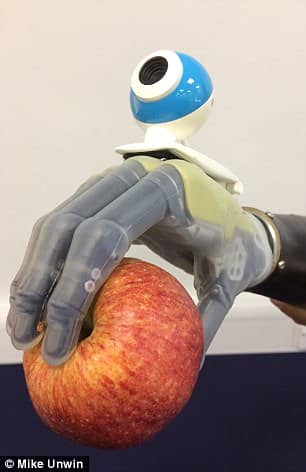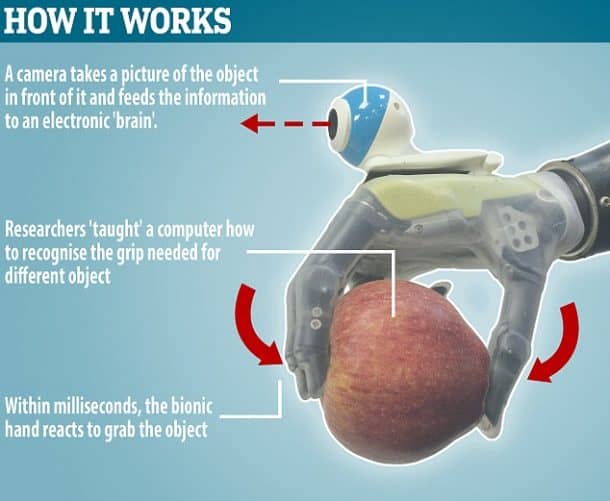Say goodbye to the dumb prosthetic hands that use are a hassle to train and work with. This revolutionary bionic hand can ‘see’ the objects instantly and work out the type of grip needed to help the wearer. The hand can self-select one of four grips by detecting whether the wearer wants to, for example, pick up an apple or holding a pen between thumb and forefinger.
The wearer just has to glance at the object that is needed to be picked up and think of the grip they would want. The arm can detect a dozen of ‘trigger actions’ that are imagined by the users and use brain signals to activate muscles connected to electrodes on their stump.

The arm adds the data collected using a 99p ($1.30) webcam to work out the grasp needed and gives respite to hours of exhausting training for amputees who use traditional prosthetics. The current database of the prosthetic contains over 500 items and changes its grasp almost instantaneously.
This prosthesis is ten times faster than a traditional artificial hand and consumes mere milliseconds to respond to the user.
Dr. Kianoush Nazrpour, the co-author of the study on the prosthetic hand, said:
‘For many amputees the reference point is their healthy arm or leg so prosthetics seem slow and cumbersome in comparison. ‘Now, for the first time in a century, we have developed an “intuitive” hand that can react without thinking.’
The biomedical engineers at Newcastle University who created the hand hope that it will be available for NHS patients within two years.
The arm has been tested on two amputees, and it worked with an accuracy of up to 88 percent.
Amputee Doug McIntosh, 56, who used the “seeing” hand described the experience as ‘completely mind-boggling.’ He lost his right hand and forearm to cancer in 1997 and used the technology to pick up a small bottle, a CD, and a credit card.

He commented,
‘It’s quite emotional when the thing comes to life. It was almost like a flashback to the last night before I had my amputation, but it was emotional in a good sense.’
On the critique of the technology only using one muscle trigger and allowing the rest of the amputated muscles wither away, Dr. Jeroen Bergmann, a wearable technology expert from the University of Oxford, replied:
‘Robust control of artificial limbs is essential and although at the moment further improvements are still needed to make the technology described in the paper applicable in the real-world, it is likely that in the future prosthetic control can benefit from this kind of development.’
Watch the magic in the video below!


